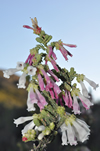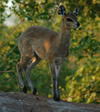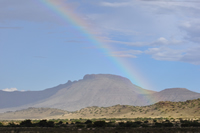This page is a photo diary which offers a tast of our lives
in the Kouga mountains.

A Symphony of Stars
1 March 2011. With the nearest city 2 hours drive away,
light pollution in our night skies is close to zero. That is why astronomers
want to build one of the biggest telescope arrays in the world in the
Karoo. On a moonless night by starlight alone one can see the silhouettes
of the surrounding trees and mountains! In late summer Orion struts his
stuff over the Klein Karoo, as we are watched by the beady eye of Sirius.
Taurus and the Seven Sisters (Pleides) rest towards the horizon, while
the Southern Cross awakes in the southern skies.
|
| |
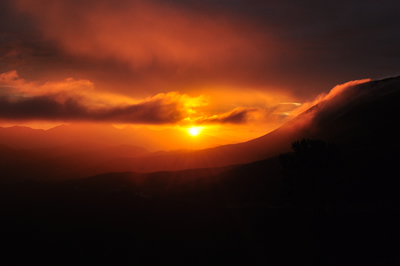
Prince Alfred's Pass by sunset
3 April 2011. One of South Africa's most spectacular
historical passes, the Prince Alfred's Pass was built over four
year by Thomas Baines, using convicts, to connect the Langkloof
Valley to Knysna. It was named after Prince Alfred Pass in honour
of Queen Victoria's favourite son, who came elephant hunting in
1867. This pass is all the more spectacular at sunset.
|
| |
Parade of Porcupines
28 September 2010. Its not usual to have 280 wildlife photos
in a week, but thats what happened during these two weeks in September
at a camera situated on our south road, not far from where we all stay.
260 were of baboons - from every angle (a few selected photos can be viewed
on our blog - bluehillescape.blogspot.com).
Standing out from the baboons was this photo of a pair of porcupine, heading
of course for our lucerne fields. Probably the same pair I have chased
after with by bicycle previously. I did that really hoping I wouldn't
cycle over one - the puncture repairs would have been endless!
|
| |
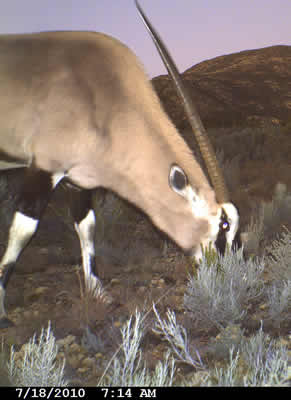
Gemsbok Dawn
28 July 2010. One of the most exciting times of the day
is after we've been out into the field to collect the memory cards from
the remote cameras scattered across the reserve. Amongst the baboon and
duiker photos (our most abundant mammals) one occasionally gets a rare
animal, or even better, a rare animal with a great background - like the
dawn on the Kouga mountains behind this gemsbok. Gemsbok are associated
with dry areas, like the Karoo and Kalahari and we are at the very southern
limit of their range. In fact, this may be the only gemsbok on the reserve
- we suspect it escaped from a local gamefarm where they are hunted.
|
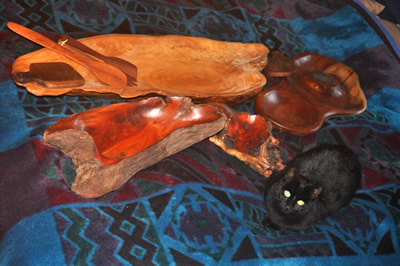
Ed's Wood
14 July 2010. We had the pleasure this week of visiting
the Feathers gallery in Knysna, which displays beautifully detailed hand-crafted
birds. Featured in this photo are a collection of unique bowls and crafts
created from driftwood by Edward Walker, who's work is on display at the
gallery under the watchfull eye of his friendly cat Leo. Blue Hill Escape
is about 80km from Knysna via the Prince Alfred's Pass.
|
| |
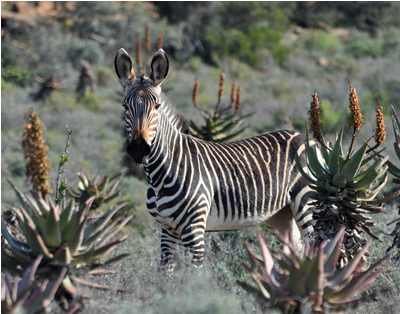
Cape Mountain Zebra
10 July 2010. We were barreling along the northern
side of the Baviaansberge, on the Baviaans T2 route, when we startled
a small herd of Cape Mountain Zebra. After coming to a halt, they
relaxed and started posing among the Aloes. Cape mountain zebra
(Equus zebra zebra) is the smallest of the zebras and a
South African endemic. They are classified as vulnerable and only
about 400 individuals remain. They were the highlight of our 6 hour
drive from Patensie, which included the breath-taking Grootrivier,
Elandsberge and Grasnek passes in the shadow of the Cockscomb peak.
|
| |

Giant Aloe
19 June 2010. Some places like to make themselves
famous by creating the biggest pineapple, spider, or wombat. In
the Klein Karoo we grow giant Aloes. This Aloe ferox is
related to that famous Aloe vera - a popular ingredient
in skin cream. Trying to harvest this Aloe's leaves would be a bit
problematic though.
|

Fire
28 June 2010. Last week snow, this week fire. The
conservancy with which we are associated have a contract with the
Department of Water's 'Working for Water' program. Part of this
involves clearing wattle infestations. Black and Silver wattle introduced
from Australia overgrow the streams, shading out and out-competing
indigenous vegetation. The wattle is cut, and later burnt. This
has to take place several times as the seeds are very persistent.
|
| |
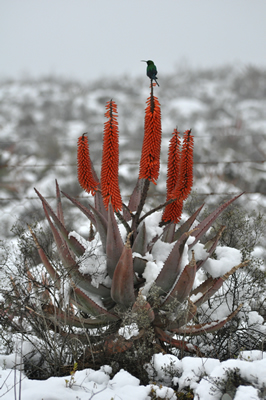
Malachite sunbird on Aloe ferox -but in
the snow
15 June 2010. As the Aloes come into bloom across
the hillsides of the Renosterbos, lighting the hills with beacons
of red, a fairly common sight is to see an emerald green Malachite
sunbird amongst the flowers, seeking out a nectar energy boost.
That must have been especially needed on this day when the Karoo
experienced the heaviest snows in 10 years.
|
| |
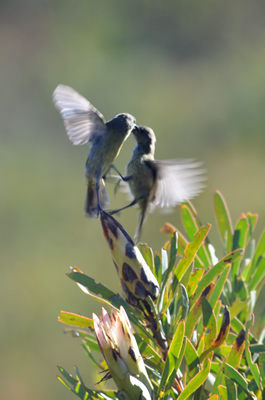
Orange-breasted sunbird fun
While on a winter walk, I came across a family of
Orange-breasted sunbirds - at least three youngsters with their
nervous parents. The youngsters would approach quite curiously to
observe me. After a while they relaxed and started to play king-of-the-castle,
the castle in this case a Suikerbossie (Protea repens)
13 June 2010
|
|




